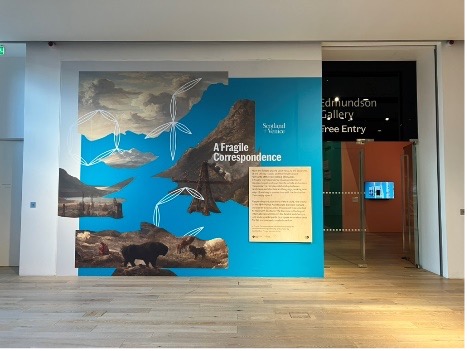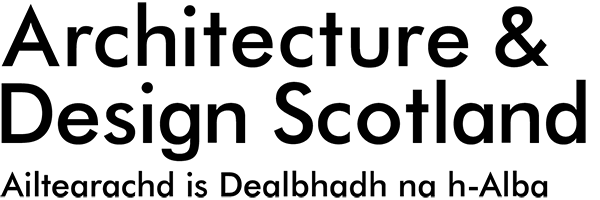The Recap: A weekly update from Architecture and Design Scotland

Welcome to the Recap - a short regular update blog from Architecture and Design Scotland. This is based on our internal blog that is shared with staff and board members on Fridays. This blog covers weeks ending January 10-February 7 2025.
A Fragile Correspondence | Dezeen's Top 10 Exhibitions of 2024 and a new podcast
At the end of last year, Dezeen included the V&A Dundee (previously Scotland + Venice) exhibition A Fragile Correspondence in its Top 10 list of best architecture and design exhibitions in 2024. This is a further international achievement and recognition for the exhibition, following its placement in Architects' Journal's 'Top 10 to see at the Venice Biennale' in 2023.
Over the festive break, our Principal Design Officer Morag Bain and our Principal Landscape Architect Danny McKendry both visited the V&A Dundee to see A Fragile Correspondence. Morag said "It looked amazing in the space, with some fantastic additions. Raining Memories (a film and drawing), the raw square blocks and perfect spheres of Orkney stone, and the catalogue of growth in Ravenscraig, all add to the stories and appreciation of the language and naming."
While Danny described the whole exhibition as "very accessible", with "the re-wilding of Ravenscraig set against the human stories proving to be very poignant!"
V&A Dundee have since published an aligned public programme – including learning events, discussions and debates – as well as a podcast series in which the artists, designers, architects, writers and curators behind the exhibition explore the themes and ideas within it.
The exhibition is on until Sunday 25 May 2025.
Housing Emergency: Community Led and Cooperative Housing
On Tuesday 21 January, our Principal Architect Steve Malone attended an online event by The Scottish Parliament, exploring co-housing as part of a response to the Scottish Government’s declared Housing Emergency. Hosted by Ariane Burgess MSP and chaired by Professor Duncan MacLennan, the evening provided a space to discuss the opportunities and benefits of community led and cooperative housing for residents and the wider community.
Attendees heard presentations from Craig White of Agile Homes, Prof Paul Chatterton of LILAC (Low Impact Living Affordable Community) and Camilla Nielsen-Englyst of Cohousing Denmark, where community living is on the rise as a model for housing, partly due to it being more embedded in political strategies at a municipal level. Camilla shared an interesting example of a project where a former hotel had been retrofitted to create 30 co-housing apartments, and other examples of co-housing within or near town centres and amenities. Co-housing communities, a middle way between social housing and for-profit housebuilding, are common in Europe and North America, but not yet in Scotland.
Following the presentations, some community led projects in Scotland (Hope Cohousing in Orkney and Lenzie Community Development Trust) shared the challenges they are facing in bringing projects to fruition. Housing Minister Paul McLennan rounded off the event by offering areas of potential focus to help take cohousing forwards in Scotland: through becoming more embedded into SG policy and local housing strategies; through innovation around finance and funding; and support through planning.
Three ways to welcome a new year for Scottish planning
“What does 2025 hold for planning? We asked a planner from each of the UK’s four nations to tell us what they think the profession will accomplish in 2025 and what they’re hoping to achieve in their work. Here's what Heather Claridge had to say.”
Read our Director of Design, Heather Claridge's brilliant article in The Planner, in which she shares her three key aspirations for Scottish planning in 2025: https://www.theplanner.co.uk/2025/01/27/three-ways-welcome-new-year-scottish-planning
Flood Resilience Conference 2025
On 29 January, Steve Malone headed to Dynamic Earth for day one of the Flood Resilience Conference 2025. Over 600 attendees (online and in-person) heard from and engaged with a variety of speakers through plenaries, break-out sessions, interactive Q&As and panel discussions, all exploring the theme of ‘Taking actions to implement the Flood Resilience Strategy’.
Chaired by Verture (previously, Sniffer) CEO Jo Kerr, the morning session included presentations from Acting Minister for Climate Action Alasdair Allan MSP launching the Scottish Flood Resilience Strategy. Pupils from Portobello High School and Irvine Royal Academy shared on their thoughts on flood resilience, climate adaptation and aspirations of a younger generation, and Balfour Beatty and AECOM presented on innovation for flood resilience. An afternoon breakout session on engaging with coastal communities drove home some of the serious impacts and challenges that flooding is having – and will continue to have – on our coastal communities, towns and shorelines.
On Wednesday, our Senior Design Officer Laura Hainey arrived in time to hear a seminar on retrofitting property resilience measures, noting the growth of flood resilience products and industry, and the need for design to increasingly consider recovery from the impacts of floods (for example, designing in higher plug points).
In a session on “Tools to support creating flood resilient places” Cat Payne of Verture spoke about the Climate Ready South East Scotland Story map which is collecting stories of lived experience of the changing climate. These varied from small spots of flooding, to a flooded building site – resulting in mostly self-employed tradespeople being out of work for some time. Cat noted the importance of collecting stories where people are, to ensure true representation and involvement. Kat Hasler of Scottish Government then introduced the Place Standard with a Climate Lens, first giving an outline of the place standard and the premise behind it, then following up with the additional depth the Climate lens can add to exploring mitigation and adaptation with communities.
After Cat and Kat, came a presentation on the CAT project. Speaking about the Climate Action Town Toolkit, Laura took attendees on a tour through the process – from understanding who should be involved and the climate risks, to generating and delivering ideas – outlining the tools in from toolkit, many of which are not new. Laura then gave a case study of the Climate Action Towns project in Stevenston where flood and coastal resilience, as well adapting to the changing climate, were key. Laura outlined the process and identified shared concerns from both the community groups and local authority, which led to: an expedited coastal adaptation study, better collaborative working, and the community company seeking asset transfer of a greenspace away from the coast for community use, and with potential for upstream flood attenuation measures.
Back to Benarty
On Thursday 23 January, our Interior Designer Alex Laurenson was invited back to Benarty for the launch of their Local Place Plan (LPP), throughout which the Climate Action Towns project work was embedded.
Alex said "It was great catching up with the community council and Coalfields Regeneration Trust, who have put a huge amount of work into the LPP and getting it across the very tight deadline."
Head image: The entrance to the A Fragile Correspondence exhibition at V&A Dundee. Credit: ArcDesSco
